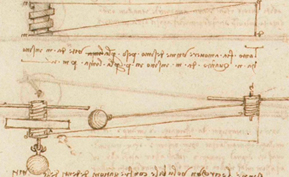
National Library, MadridSketch from 1493: a screw thread (upper drawing) and an inclined planeNational Library, Madrid
In a book published in 1797, Italian physicist Giovanni Battista Venturi recognized the pioneering role played by Italian inventor and artist Leonardo da Vinci (1452-1519) in his presentation of the principles of friction, the force associated with the resistance exhibited by two surfaces in contact with one another. Now, Ian Hutchings, a professor of manufacturing engineering at the University of Cambridge, England, has retraced da Vinci’s work in that field, by way of the Italian artist’s manuscripts scattered among the libraries of Europe. He concluded that da Vinci made his first notes on the probable laws of friction in 1493 (Wear, August 2016). According to Hutchings, da Vinci continued to think about this subject for more than 20 years and incorporated his empirical knowledge of friction into designs of gears and other devices. In his notebooks, he stated several times that “every frictional body has a resistance of friction equal to one quarter of its weight.” Since his notations were not published, da Vinci had no direct influence on tribology, the study of friction between surfaces. The two fundamental laws of friction, associating that force to the weight or pressure between surfaces in contact, were announced in 1699 by French physicist Guillaume Amontons and confirmed by another Frenchman, Charles-Augustin de Coulomb, in 1781.
Republish